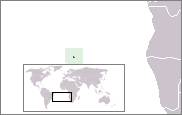Saint Helena crake facts for kids
Quick facts for kids Saint Helena crake |
|
|---|---|
| Conservation status | |
| Scientific classification | |
| Genus: |
Zapornia
|
| Species: |
astrictocarpus
|
 |
|
| Location of Saint Helena. | |
| Synonyms | |
|
Porzana astrictocarpus |
|
The Saint Helena crake (Zapornia astrictocarpus) was a small bird that couldn't fly. It lived only on Saint Helena, a faraway island in the South Atlantic Ocean. This bird was one of two types of flightless rails that lived on the island until the early 1500s. Sadly, it is now extinct.
Discovering the Saint Helena Crake
In 1963, an American bird expert named Alexander Wetmore found some bones of a large flightless bird on Saint Helena. He called this bird the Saint Helena rail. Later, in 1973, another American scientist, Storrs Olson, found more bones in the same area. These new bones were smaller than the ones Wetmore found.
Olson realized these smaller bones belonged to a different bird. He found almost complete skeletons of this new species. Because of the special shape of its wing bone (called the carpometacarpus), Olson gave it the scientific name Porzana astrictocarpus.
Why the Saint Helena Crake Disappeared
Scientists believe the Saint Helena crake was related to the Baillon's crake, a bird found in Europe and Africa. Over time, because there were no natural enemies or predators on Saint Helena, the crake didn't need to fly to escape danger. So, it slowly lost its ability to fly.
However, things changed around the year 1502. People started to settle on Saint Helena. They brought many different animals with them, like cats, rats, and pigs. These new animals were predators that the flightless crake couldn't escape from. They also competed with the crake for food and space. Because of these new challenges, the Saint Helena crake could not survive and eventually became extinct.
See also
 In Spanish: Porzana astrictocarpus para niños
In Spanish: Porzana astrictocarpus para niños


